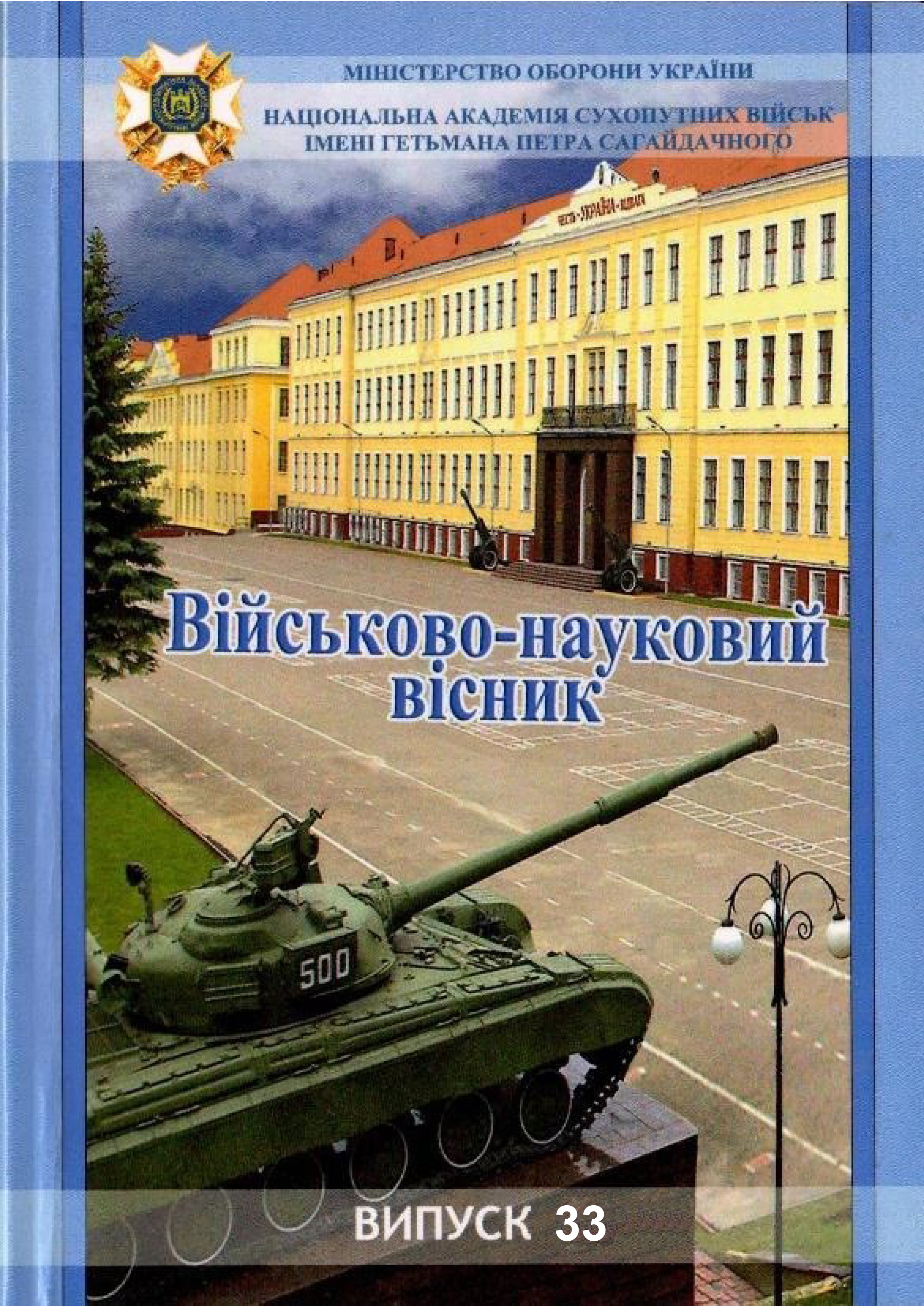СТАНОВЛЕННЯ ТА РОЗВИТОК ОФІЦЕРСЬКОГО КОРПУСУ ЗБРОЙНИХ СИЛ УКРАЇНИ (кінець XX – початок XXI ст.)
DOI:
https://doi.org/10.33577/2313-5603.33.2020.48-60Ключові слова:
офіцерський корпус, чисельність, Збройні Сили УкраїниАнотація
Дослідження проведено на основі широкого кола опублікованих та відомчих документів, які сприяли опису історичного процесу розвитку системи формування офіцерського складу Збройних Сил України та проблем, які виникали при її становленні. В статті здійснено узагальнення кількісно-якісних характеристик офіцерського складу, розпочинаючи з проголошення незалежності України.
На основі системного підходу та застосування наукових методів проведено оцінювання діяльності керівного складу Збройних Сил України та їх внесок в процес становлення та розвитку офіцерського корпусу в Україні.
Наукова новизна одержаних результатів полягає в аналізі передумов становлення та розвитку офіцерського корпусу Збройних Сил України, їх всебічній оцінці, а також розроблених висновках щодо удосконалення нормативно-правової бази.
Посилання
Dashkevych O. (2012). The method of periodization as a tool of historical research of activity of personnel bodies of the Armed Forces of Ukraine on the issues of manning the positions of senior officers (1991–2011)]. Military-Historical Bulletin. 3(5). pp. 62-74;
Hybrid War in Ukraine: Expert Opinions (2014). Available from http:// polonews. in.ua/aktualnosci/polityka/gibridna-vijna-v-ukrajinidumki-ekspertiv.html [Accessed 01.03.2020];
Information on the circumstances of Ukraine's loss of control over the Black Sea Fleet of the former USSR, the circumstances of its division between Ukraine and the Russian Federation, and facts showing the presence of signs of theft of naval property. Available from https://www.ukrmilitary.com/2019/06/tsk-dodatok1.html. [Accessed 01.03.2020];
Information on the distribution of warships and ships of the Black Sea Fleet, military equipment and armaments between Ukraine and the Russian Federation (according to the Agreement between the Ukraine and the Russian Federation on the parameters of the division of the Black Sea Fleet of May 28, 1997), as well as information on the movement of the naval composition of the Ukrainian Navy. Available from https://www.ukrmilitary.com/2019/06/tsk-dodatok2.html. [Accessed 01.03.2020];
Kolesnyk V. A. (2001). Training of officers in the National Defense Academy of Ukraine 1992-1999. Kyiv, National Defense Academy of Ukraine, 170 p.;
Kolos R. L. (2004). Training of officers for the Armed Forces of Ukraine based on the experience of the Military Engineering Institute 1991-2000]. Kyiv, National Defense Academy of Ukraine, 187 p.;
Korolov S. S. (2006). Social protection of military personnel of the Armed Forces of Ukraine (1991-2005): historical aspect. Kyiv, National Defense Academy of Ukraine, 190 p.;
Mashtalir V. V. (2008). Problems of formation of officers of the Armed Forces of Ukraine in the transition period of formation of a professional army. Fourteenth All-Ukrainian Conference of Young Historians of Education, Science and Technology and Specialists: Materials of Conference, Kyiv, 130-134 pp.;
Mashtalir V. V. (2009). History of the formation of the officer corps of the Armed Forces of Ukraine. Topical issues of science and technology: materials of the 8th All-Ukrainian. Research Practice Conference. Kyiv. 72-73 pp.;
Mashtalir V. V. (2009). The main stages of formation of the officer corps of the Armed Forces of Ukraine. History of Ukrainian science at the turn of the millenniums. № 40. 180-185 pp.;
Mashtalir V. V. (2009). To the history of creation of the legal framework for regulating the activity of the officers of the Armed Forces of Ukraine. Questions of history of science and technology. Vol. 2 (10), pp. 22-24;
Mashtalir V. V. (2012). The Soviet legacy and its influence on the formation of the officers' corps of the Ukrainian sample after the declaration of independence of Ukraine. Land Forces of the Armed Forces of Ukraine: History, Present, Development (to the 20th Anniversary of the Armed Forces of Ukraine)]: materials of scientific-practical conference. 2012. pp. 275-276;
On the declaration of independence of Ukraine: The resolution of the Verkhovna Rada of Ukraine of August 24 1991 № 1427-XII (1991) Vidomosti Verchovnoyi Rady Ukrayiny [Information of the Verkhovna Rada of Ukraine]. № 38. P. 502;
On the Transformation of the Joint Defense and Military Command System in the Armed Forces of Ukraine: Ministry of Defense of Ukraine order № 141 of March 29, 2019 (2019). Available from http:// www.mil.gov.ua/content/ mou_orders/ 141_ nm_ 2019.pdf [Accessed 01.03.2020];
Report of the Temporary Investigation Commission of the Verkhovna Rada of Ukraine to Investigate Information on the Thefts in the Armed Forces of Ukraine and the Undermining of the State's Defense Capability from 2004 to 2017. Available from https: //www.ukrmilitary.com/2019/06/rozkradannya-zvit-1.html [Accessed 01.03.2020];
Romanchenko I. & Dyenyezhkin M. & Moroz M. (2006) To determine the rational ratio of senior and junior officers in the Armed Forces of Ukraine. Science and defense. Iss. 1. pp. 14–19;
Senyuk O. V. (2014). Historical stages of formation and development of military training of students in higher military educational establishments, military educational units of higher educational establishments of Ukraine. Journal of the National University of Ostroh Academy. Series: The Law. Iss. 1(9). pp. 1-11;
Shlykov V. (2001). What ruined the Soviet Union? US intelligence on Soviet military expenditures. Military Gazette. № 8. pp. 1-17;
The White Book 2005: Ukraine's defense policy (2006). Kyiv, Zapovit. 134 p.
##submission.downloads##
Опубліковано
Номер
Розділ
Ліцензія
1. Відповідальність за точність поданих фактів, цитат, цифр і прізвищ несуть автори матеріалів.
2. Редакція матеріали не повертає.
3. Автори залишають за собою право на авторство своєї роботи та передають журналу право першої публікації цієї роботи на умовах ліцензії Creative Commons Attribution Non-Commercial License, котра дозволяє іншим особам вільно розповсюджувати опубліковану роботу з обов'язковим посиланням на авторів оригінальної роботи та першу публікацію роботи в цьому журналі.
4. Автори мають право укладати самостійні додаткові угоди щодо неексклюзивного розповсюдження роботи у тому вигляді, у якому вона була опублікована цим журналом (наприклад, розміщувати роботу в електронному сховищі установи або публікувати у складі монографії), за умови збереження посилання на першу публікацію роботи в цьому журналі.


